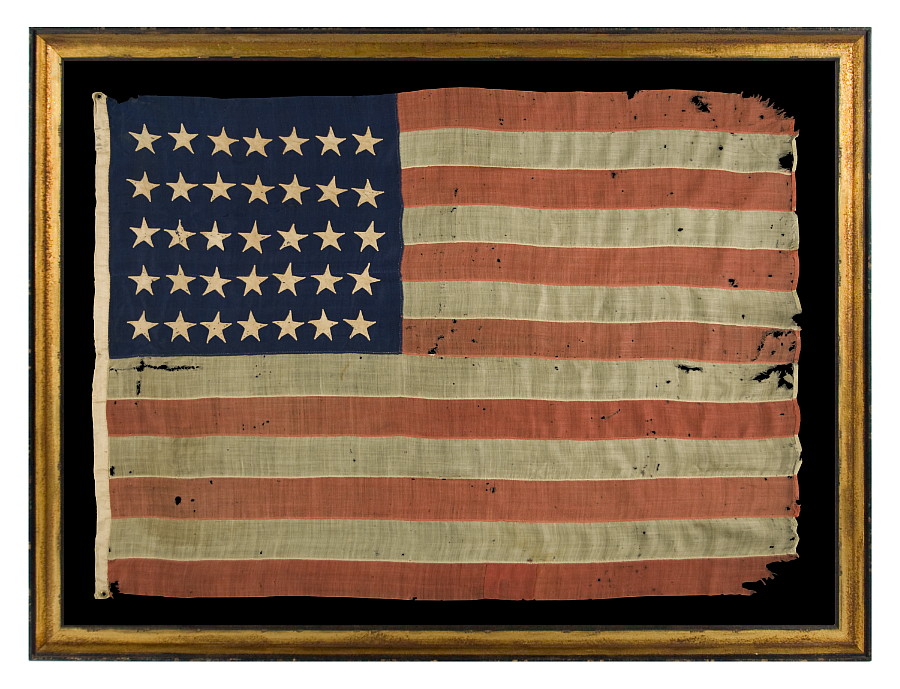
| |
ENTIRELY HAND-SEWN FLAG OF THE CIVIL WAR PERIOD, WITH 35 STARS, 1863-65, WEST VIRGINIA STATEHOOD, IN A SMALL SCALE FOR THE PERIOD AND HIGHLY UNUSUAL WITH DIFFERENT SIZES OF STARS ON ITS OPPOSING SIDES |
|
| Available: |
Sold |
| Frame Size (H x L): |
Approx. 62" x 80" |
| Flag Size (H x L): |
50.5" x 68.5" |
|
| Description....: |
|
ENTIRELY HAND-SEWN FLAG OF THE CIVIL WAR PERIOD, WITH 35 STARS, 1863-65, WEST VIRGINIA STATEHOOD, IN A SMALL SCALE FOR THE PERIOD AND HIGHLY UNUSUAL WITH DIFFERENT SIZES OF STARS ON ITS OPPOSING SIDES:
Entirely hand-sewn, 35 star American national flag of the Civil War period. West Virginia was admitted into the Union as the 35th state on June 20th, 1863, a few days before the battle of Gettysburg. The 35th star was officially added on July 4th of that year and the flag technically remained official during the closing of the war. Production would have generally ceased, however, just one year later, with the addition of the 36th state.
The stars have particularly nice profiles and the attractive nature of the hand-stitching makes them visually intriguing. They are made of cotton and double-appliqued, which means that they were applied to both sides of the blue canton. The manner in which they are sized on the two different sides is very unusual. On the obverse (front) they are larger than on the reverse, where the slightly smaller stars fit neatly inside the perimeter of their large counterparts. The result is two parallel rows of stitching instead of one. Sometimes there is slight variation from one side to the next, but not typically, and I have not before seen this great a difference on a flag with double-appliqued stars. The crude trait is exemplary, however, of the hand-constructed nature of many Civil War period textiles.
The stripes and canton of the flag are made of wool bunting. The canton is pieced from two lengths of blue fabric because blue wool bunting was only available in a width of eighteen inches. The rectangular patch along the top stripe is a period repair, executed with the same wool fabric. This demonstrates that the flag saw wartime use and the patch is nice accompaniment to the expected wear that endearingly shows its age. There is a coarse linen binding along the hoist, with two hand-made brass grommets. Grommets were first patented in 1847 and the original patent was an improvement upon an earlier design. By 1870 there were 5 patents. On flags, their presence does not generally appear before the Civil War, when they were used amply by many flag-makers.
A stencil along the hoist reads "4 x6" to indicate size. These dimensions are particularly attractive, because while this would be a pretty large flag by today's standards, it is unusually small for the Civil War period, in which most flags were greater than 8 feet in length. A garrison flag was generally 35 or 45 feet. Standard military, ground-use, infantry battle flags were 6 x 6.5'. Flags were large in order to serve their utilitarian purpose as signals. Today their use is largely decorative, but this wasn't so in the mid-19th century.
Mounting: The flag was hand-stitched to 100% silk organza for support on every seam and throughout the star field. It was then hand-stitched to 100% cotton twill, black in color, which was washed to reduce excess dye. An acid-free agent was added to the wash to further set the dye and the fabric was heat-treated for the same purpose. The mount was placed in a black-painted, hand-gilded and distressed Italian molding. The front is U.V. protective acrylic.
Condition: The folded binding is split along the hoist end. There are various losses and repairs throughout that add great character. Many of my clients prefer early flags to show their age and history of use. |
|
|
|
| Collector Level: |
Intermediate-Level Collectors and Special Gifts |
|
| Flag Type: |
|
|
| Star Count: |
35 |
|
| Earliest Date of Origin: |
1863 |
|
| Latest Date of Origin: |
1865 |
|
| State/Affiliation: |
West Virginia |
|
| War Association: |
1861-1865 Civil War |
|
| Price: |
SOLD |
|
| |
Views: 3028 |
|
|
|

